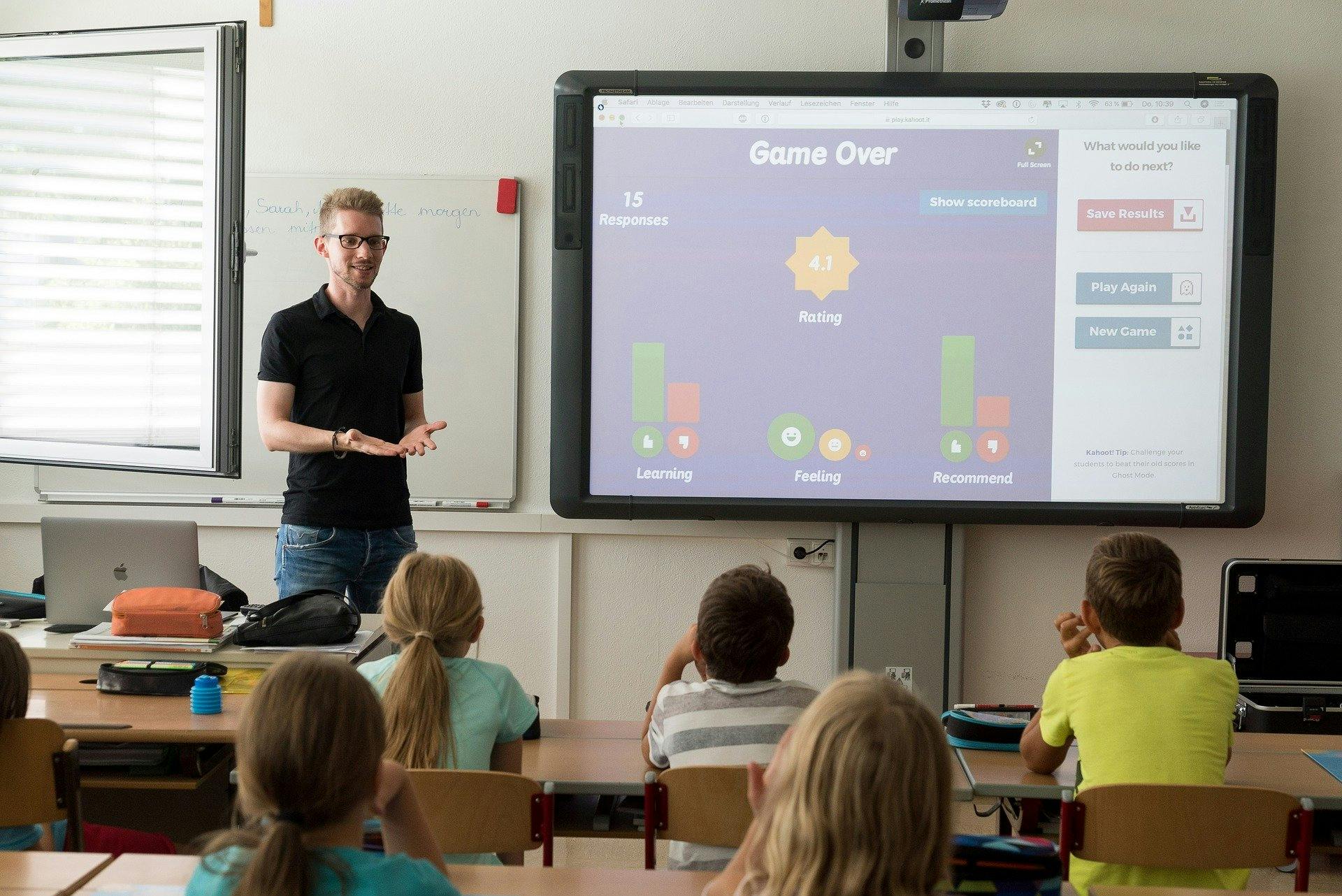How to Use Bloom's Taxonomy to Support Learning Objectives
All Posts
Written by Melanie Arden
Category
- Teaching Tools
Contents
Bloom's taxonomy offers teachers a sound structure to help them design courses that support learning outcomes. The framework allows educators to create:
- Course materials
- Classroom activities
- Assignments and projects
- Assessments
- Group discussions
- Lesson plans that are simple or challenging
Benjamin Bloom's taxonomy provides educators with a powerful framework of cognitive skills and helps students build their knowledge on each level. A pyramid-shaped hierarchy of learning objectives gives students a clear picture of what they'll learn in each step.
As students progress through all stages, they improve their skills from previous levels and subcategories contained within the taxonomy for learning.
Teachers should consider the grade levels, students' foundational knowledge and learning objectives when creating lesson plans or course materials.
What is Bloom's taxonomy?

Bloom's taxonomy categorizes learning objectives into steps based on varying levels of difficulty and cognition:
- Remember — Recalling previous knowledge from long-term memory
- Understand — Interpret the meaning of a message through verbal and written cues
- Apply — Learn how to put a procedure into practice
- Analyze — Breaking down the material into parts and understanding how these units connect to each other
- Evaluate — Using established criteria to assess through fact-checking and review
- Create — Combining each unit into a complete structure
The hierarchical model contains a logical progression from the foundation — Remember — until students reach the upper level, Create. Each level builds on top of the other to reinforce learning objectives throughout all stages.
The top three learning objectives include the psychomotor, affective, and cognitive domains. Within each level, students can expect to encounter simple to complex learning. Teachers should spell out learning objectives for students and what they can expect to achieve when they complete their course.
When educators use this taxonomy in course design, students can reach attainable goals.
How should you use Bloom's taxonomy in the classroom?
Below, we've outlined a few tips to help you implement this taxonomy for learning:
- Make connections by encouraging deeper thinking.
- Use Bloom's taxonomy verbs when describing the learning objectives of all six stages to students.
- Employ Bloom's taxonomy to distinguish between lessons. It's important to include active verbs in class discussions to determine students' comprehension of the course materials.
Students can achieve measurable success when educators use Bloom's taxonomy in the classroom. Keep reading to find out how to get started!
Bloom's taxonomy history
Benjamin Bloom created Bloom's taxonomy in 1956 to categorize educational goals into specific stages. These classifications were intended to provide a stronger framework for assessing college student performance. The primary goal was for students to achieve an enriched education through six pillars of learning.
The original Bloom's taxonomy had six stages of cognitive processes:
- Knowledge
- Comprehension
- Application
- Analysis
- Synthesis
- Evaluation
Revised Bloom's taxonomy, explained
In 2001, Dr. Lorin Anderson and David Krathwohl revised Bloom's framework to emphasize the importance of active learning. The most notable changes include the removal of Synthesis and replacing it with Creation at the highest level of the taxonomy. The change makes it easier for students to understand the learning goals for all levels.
They also included three learning objectives categorized into domains:
- Cognitive (knowledge-based)
- Affective (emotion-based)
- Psychomotor (action-based)
Anderson and Krathwohl replaced the older version of nouns with verbs to provide clear learning objectives and promote active learning.
The goal of the revised version encourages higher-level thinking for students, better lesson plans, and more effective evaluation.
Today, most educational professionals use the revised Bloom’s taxonomy.
Different levels of Bloom's taxonomy

Bloom's taxonomy advises educators to teach students from the bottom and move up toward the top level. Lower cognitive processes provide a foundation for students to build their knowledge. As students master the skills at each level, they develop a higher degree of cognitive tasks and learning.
Teachers should use the taxonomy to plan courses to build and reinforce students' knowledge. Always begin course planning with the first stage: remembering.
1. Remember
Remember is the first step in the taxonomy. Give your students lessons and activities that build their memory and ability to recall information, such as memorizing poetry or remembering specific facts. Use verbs such as define, identify and label to help students build a successful foundation.
Provide students with specific learning objectives. For example, students can memorize poems like “Sonnet 116” by William Shakespeare in English class, or correctly fill in a multiplication chart.
2. Understand
Understand encourages students to interpret course materials, facts and ideas with an explanation of what they've learned in their own words. Use verb keywords like describe, show, give examples, and outline for this stage.
Reading comprehension activities and cooperative learning are well-suited to this stage of learning.
3. Apply
At the third level, students take their knowledge and apply it to real-world situations. They can use what they’ve learned to produce a group project on daily nutrition or calculate how much they need to save for a new computer using multiplication strategies.
Use these keyword verbs like apply, show and use when teaching in this stage.
4. Analyze
Analyze encourages students to stretch their abilities and aim for higher levels of learning. They'll use critical thinking skills to understand how concepts work based on parts and as a whole. Plan media literacy activities or current events presentations to help students apply their skills.
For this stage, use verbs like breakdown, categorize, analyze and simplify.
5. Evaluate
The fifth level of Bloom's taxonomy asks students to make an educated conclusion based on facts, analysis of information, and novel solutions. Use inquiry-based learning activities or interdisciplinary activities to help students deepen their understanding and critical thinking.
Examples of verbs to use in this stage include choose, support, determine, judge, justify and evaluate.
6. Create
In the last stage, students can use their knowledge to create or build a physical item, such as writing an essay, a flowchart, or artwork. Good verbs for this stage include design, build, invent, create, change and develop.
Projects from this stage can often be included in a student portfolio as part of student-led conferences.
Bloom's taxonomy verb tables
Bloom's taxonomy contains action verbs and tables geared toward each level. The verbs correlate with learning objectives to help you plan lessons that are connected with course goals. The learning targets, combined with measurable verbs, elevate students' thinking to greater levels and depth.
Be sure to use the correct verb for each objective and level. The verb list helps students reach higher levels of understanding and knowledge in the six levels. Although the same verb may be used in more than one level, the objectives are different.
How teachers can use Bloom's taxonomy in the classroom

Revisit the foundations of Bloom's taxonomy often to make sure your teaching is in line with best practices. Incorporate the principles into your course to help students develop critical thinking skills and reach other educational targets.
You can use this taxonomy of educational objectives for active online learning. Students use mobile devices to access online platforms and course materials. They learn to become more responsible for their education and strive to achieve their goals.
Encourage students to take part in group discussions and activities tailored to each level. For example, open a debate among students for the Evaluate stage. You'll be surprised to see the viewpoints they come up with.
Looking for more tips to use in the classroom?
Here are six strategies educators can use to teach their students effectively:
Use all levels. It may be tempting to disregard the lower levels. However, each step adds value to your students’ educational experience and helps them build on previous knowledge.
Apply Bloom's spiraling process. Begin from the bottom stage and work your way up toward the create stage. Use Bloom's spiraling process to create lessons and assessments.
Make good use of technology. Use apps, social media, and online forums for collaboration and socialization. Remind students to practice internet safety when collaborating with their classmates.
Allow your students to take initiative. Invite students to take the lead by contributing their own thoughts and ideas at all levels.
Leverage project-based learning. Offer students relevant projects they can complete while following multiple taxonomy steps. For example, they may choose climate change as their topic. They can begin with Remember by defining climate change and illustrating related challenges. Next, they'll progress through Understand by gathering more information and interpreting the results.
Offer rewards for your students. Give your students positive encouragement as they advance through the stages toward the top. If they take too long in one stage, offer them incentives or recognition for their efforts with rewards, such as painting kindness rocks or becoming a teacher's helper for an afternoon.
Bloom's taxonomy learning objectives

Bloom's taxonomy is split between three hierarchical learning objectives or domains with classifications based on details and challenges. The educational goals for these domains add new understanding, insight, skills and a bright outlook for students.
The cognitive domain
The cognitive domain is knowledge-based with a focus on developing intellectual skills and higher-order thinking. All six taxonomy stages come into play in this domain.
It is important to note that students must build their factual knowledge by starting at the bottom with the "remember" stage. They'll develop the ability to recall information, paraphrase, and expand their understanding with subsequent taxonomy steps.
The affective domain
The affective domain focuses on students’ attitudes and emotions about themselves and their studies. Give students learning opportunities to develop empathy, patience, and personal values. Place an emphasis on listening skills, conflict resolution, and respect during social emotional learning activities.
Here are a few examples to try with your class:
- Instruct students about self-reliance and show ways they can work independently.
- Present self-regulation techniques on what kids can do when something doesn't go their way.
- Teach cooperation and teamwork through group activities or class projects. Students learn how to contribute and respect each other's ideas.
The psychomotor domain
The psychomotor objective emphasizes physical abilities, motor skills, and coordination. Teachers should offer students opportunities to develop dexterity and other physical capabilities:
- Observe and correct negative behavior by reinforcing positive qualities and situations.
- Practice physical balancing and coordination activities through games, sports, or short yoga sessions.
Harness Bloom's taxonomy to help your teaching
Educators are encouraged to use Bloom's taxonomy to prepare lesson plans and course materials. They should use all six stages and apply the strategies mentioned in this post.
Provide the best educational experience with this taxonomy. Your students will reap the benefits as they grow their knowledge, skills, and confidence.
Prodigy Math Game is a game-based learning platform that makes elementary and middle school math fun. Plus, with a research-backed logic model and adaptive algorithm, you can be confident you’re getting effective and easy to use tools that can make a difference in your math classroom!
Sign up for your free teacher account today to get easy differentiation, real-time insights into student work and more ways to motivate your entire classroom.



